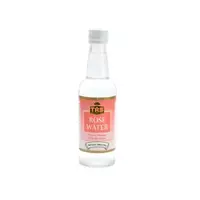Rosewater

Rose water is nothing more than an aqueous solution, which is obtained by distillation of pink petals. People have been using and making rose water since ancient times. This is primarily due to the unique taste and aroma properties of the product. It is also noteworthy that rose water has found application in both cooking and cosmetology. Often, the food industry uses rose essence or a concentrate of essential oil obtained from rose petals. In ancient times, the rose was called the "queen of flowers, " this title has survived behind the flower to this day.
In global culture, rose is considered a symbol of beauty and natural perfection. The delicious appearance and enchanting aroma of the rose cannot be confused with other plants. The healing properties of pink petals were used back in ancient Greece. The founding fathers of modern medicine Avicenna and the famous Hippocrates described the beneficial properties of a rose as well as rose water. In those distant times, rose water was used as a fairly expensive medicine that only noble citizens could afford.
Composition of rose water
Interestingly, rose water was the first to be used by the harsh wars of ancient Persia. And then the Romans, who adopted the custom of using rose water in order to periodically refresh their skin on long trips under the scorching sun. The refreshing properties of the active substances included in rose water are currently used in cosmetology. As a rule, certain varieties of the plant are used to make rose water, for example, Damascus rose. A completely different use of rose water was found among the peoples of Asia, as well as in the Middle East, who have long used pink petals in cooking.
Until now, India makes famous national sweets with rose water, which gives confectionery an amazing aroma. Interestingly, the composition of pink water used for culinary purposes does not differ from cosmetic distillate. The researchers found written sources dating back to 916, in which the Arab philosopher Ibn Khaldun detailed the process of making rose water, as well as obtaining essential oil from the petals of the pink inflorescence.
It is noteworthy that during the early Middle Ages, rose water acted as a kind of currency or a means of settlements between merchants. This speaks of the special value of rose water for people of that era. The largest rosewater industries are located in France and Germany. Rosewater is considered a must-have ingredient for the Iranian national Falude treat.
This amazing confection is made from threads of food starch, which are poured with rose water, as well as lime juice, and then frozen. It's not uncommon for Falude to be served with ground pistachio nuts to the table. It is noteworthy that it was this dessert that for a long time was considered the first type of ice cream, the recipe of which was invented back in the 5th century.
rose water 0.1 kCal
Energy value of rose water (Ratio of proteins, fats, carbohydrates - ju):
Proteins: 0 g (~ 0 kCal)
Fats: 0 g (~ 0 kCal)
Carbohydrates: 0 g (~ 0 kCal)
Energy ratio (b | y): 0% | 0% | 0%
 Español
Español Français
Français Português
Português Русский
Русский 简体中文
简体中文 繁體中文
繁體中文 日本語
日本語 한국어
한국어 العربية
العربية Türkçe
Türkçe Қазақ
Қазақ Deutsch
Deutsch Italiano
Italiano Українська
Українська
